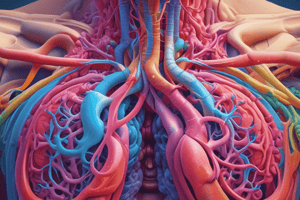Podcast
Questions and Answers
What is the primary function of oxygen in the body?
What is the primary function of oxygen in the body?
- To indirectly break down simple molecules like glucose (correct)
- To produce sound
- To eliminate carbon dioxide
- To transport nutrients
Which of the following describes the process of breathing?
Which of the following describes the process of breathing?
- Transport of oxygen within the bloodstream
- Exchange of oxygen from the atmosphere with carbon dioxide produced by cells (correct)
- Production of carbon dioxide in cells
- Exchange of nitrogen with oxygen
Which respiratory structure is known as the sound box?
Which respiratory structure is known as the sound box?
- Larynx (correct)
- Trachea
- Bronchi
- Pharynx
Which respiratory organ is used by insects for gas exchange?
Which respiratory organ is used by insects for gas exchange?
Through which respiratory structure does air pass first from the nasal chamber?
Through which respiratory structure does air pass first from the nasal chamber?
What structure divides into the right and left primary bronchi?
What structure divides into the right and left primary bronchi?
What type of respiration do frogs use besides pulmonary respiration?
What type of respiration do frogs use besides pulmonary respiration?
What helps to prevent the entry of food into the larynx during swallowing?
What helps to prevent the entry of food into the larynx during swallowing?
What is the function of cartilaginous rings in the respiratory system?
What is the function of cartilaginous rings in the respiratory system?
Which structure in the human respiratory system provides a large surface area for gas exchange?
Which structure in the human respiratory system provides a large surface area for gas exchange?
Flashcards are hidden until you start studying
Study Notes
Breathing and Exchange of Gases
Introduction
- Organic compounds like carbohydrates, proteins, and fats are broken down to derive energy, requiring oxygen (O2) and releasing carbon dioxide (CO2).
- The process of exchanging O2 from the atmosphere with CO2 produced by cells is called breathing or respiration.
Respiratory Organs
- The mechanism of breathing varies among different animal groups, depending on their habitats and levels of organization.
- Lower invertebrates like sponges, coelenterates, and flatworms exchange O2 and CO2 through simple diffusion over their entire body surface.
- Earthworms use their moist cuticle, and insects have a network of tubes (tracheal tubes) to transport atmospheric air within the body.
- Aquatic arthropods and molluscs use gills (branchial respiration), while terrestrial forms use lungs (pulmonary respiration) for gas exchange.
- Vertebrates like fishes use gills, while amphibians, reptiles, birds, and mammals respire through lungs.
Human Respiratory System
- Nose:
- A pair of external nostrils leads to a nasal chamber, which opens into the pharynx, a common passage for food and air.
- Pharynx:
- The pharynx opens into the larynx region, which leads to the trachea.
- Larynx:
- The larynx is a cartilaginous box that helps in sound production and is called the sound box.
- During swallowing, the glottis can be covered by a thin elastic cartilaginous flap called the epiglottis to prevent food from entering the larynx.
- Trachea:
- The trachea is a straight tube that extends up to the mid-thoracic cavity, dividing into a right and left primary bronchi at the level of the 5th thoracic vertebra.
- Bronchi and Bronchioles:
- Each bronchi undergoes repeated divisions to form secondary and tertiary bronchi and bronchioles, ending in very thin terminal bronchioles.
- The tracheae, primary, secondary, and tertiary bronchi, and initial bronchioles are supported by incomplete cartilaginous rings.
- Each terminal bronchiole gives rise to a number of very thin, irregular-walled, and vascularized bag-like structures called alveoli.
Studying That Suits You
Use AI to generate personalized quizzes and flashcards to suit your learning preferences.




